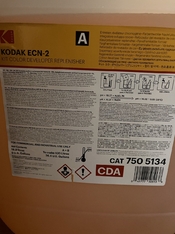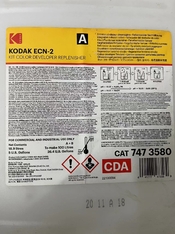Yes, the C-41 process uses a CD4 developing agent and a different set of chemistry. But this thread (and Kodak Module 7) is about a different process - ECN-2. Although you can process C-41 in ECN-2 chemistry and vice versa, in general it can lead to quite a few problems. In the Koraks god link you quoted, you can see that in addition to C-41, there is a section for ECN-2. He has slightly modified the formula, but his modifications do not change the final result. It just keeps things simple, but with the caveat that the working solution will be disposable. This avoids some chemicals that are very difficult to access or absurdly expensive, but at the same time are auxiliary and do not participate in the formation of the image.
Formulas are given for direct dilution, not for creating concentrates. Commercial packaging may include additional chemicals to provide the most stable and long-lasting solutions possible.
If I had to phrase Part A it would be:
Anti-Calcium #4 - 20.0 ml
Sodium Bromide - 12.0 g
Sodium Carbonate - 256.0 g
Sodium Bicarbonate - 27.0 g
AF-2000 - 50.0 ml
Water up to 2 liters
Part B would be:
Sodium Sulfite - 20.0 g
CD-3 - 40.0 g
Water up to 500 ml
This concentrate is for 10 liters of working solution. Mixing
4:1:15 (four parts of A, one part of B and fifteen parts of water).
Or for 500 ml working solution:
100 ml of A
25 ml B
375 ml of water
for one liter:
200 ml of A
50 ml B
750 ml of water
IMPORTANT!!!
Part B will be wrong!!! The CD3 developing agent is the critical part - while part A of the concentrate will have a long life, part B will have a very short life. The small amount of sodium sulfite cannot protect against CD3 for a long time. One way to extend life is to make a highly acidic concentrate. CD3 itself is acidic, but sodium sulfite is alkaline. There is sodium metabisulfite in the C-41 and E-6 chemistry kits which would provide some temporary solution. With ECN-2, there is no metabisulfite in the official formula, so if it is added, a lot of changes in the composition must be made. As far as I know, some commercial putties do, as well as Kodak's commercial chemistry itself.
Because things get complicated and with an increased chance of something going wrong, it's better to make only concentrate A, to which the sodium sulfite from B is added, and to remove the extra ingredients if they are hard to find or expensive. And these are AF-2000 and possibly Anti-Calcium #4. If Anti-Calcium #4 is omitted, you will need to adjust the pH of the solution. The critical component CD3 remains - you add it immediately before use in the working solution (2 g for 500 ml, 4 g for 1 liter). You adjust the pH after dissolving the CD3 because it is quite acidic.













 (and i'm not good to be master lol)
(and i'm not good to be master lol)

